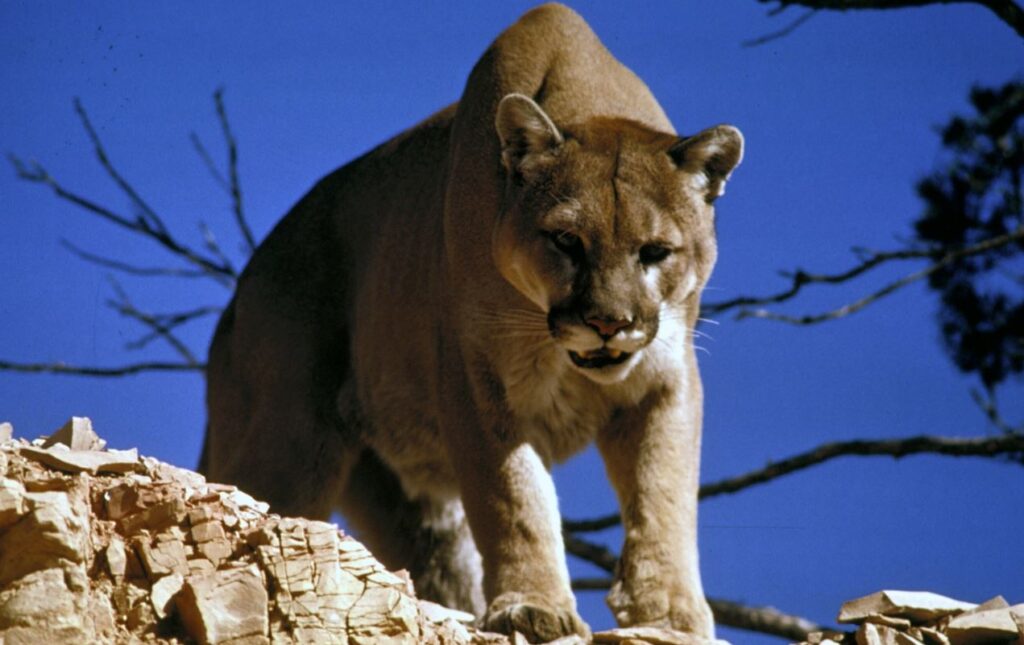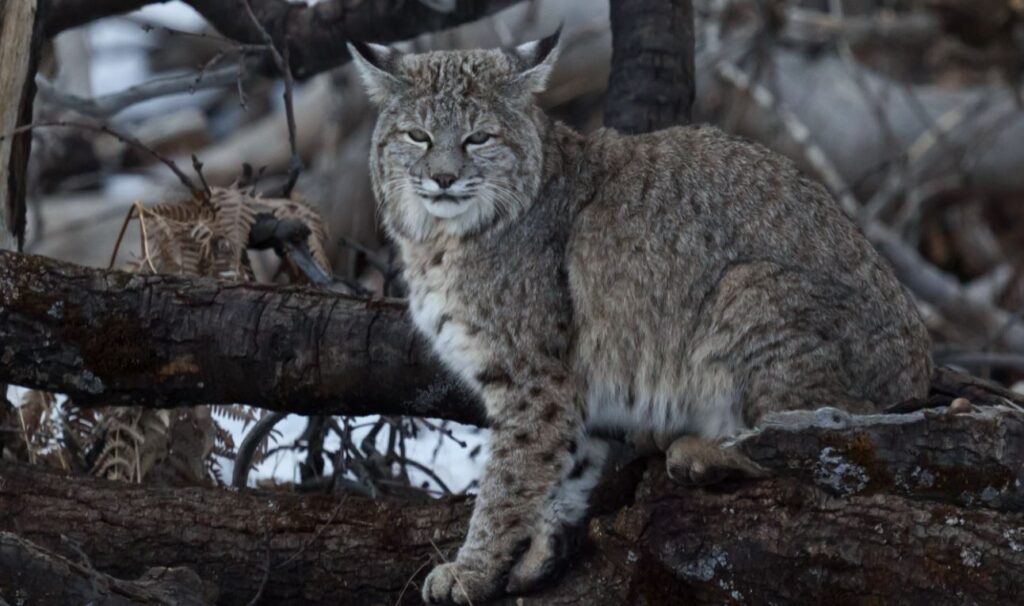Bobcat
(Lynx rufus)
Also referred to as the Red Lynx.
A medium-sized wildcat is native to North America.
1. Location
Everywhere, USA. Even though bobcats are solitary creatures, they have incredibly large populations scattered across the North American continent. Bobcats are the most abundant wildcat species found throughout North America and located anywhere from southern Canada to northern Mexico. Bobcat population has been recorded from 725,000 to over 1 million. Depending on which region of the United States, different bobcats live in specific locations. There are 12 known species of bobcats, of which some have been in existence for over 1.8 million years!
2. Bobcats vs. Mountain Lions
Bobcats are often mistaken for mountain lions. However, they share few similarities. Differences between bobcats and mountain lions include their size, tails, ears, coloring, and diets.

Bobcats look more like a Canadian lynx. Most bobcats’ ears are tufted and black at the tips, while mountain lions appear to have a common tawny-colored fur, a tan, orange/brown mixture. Both wildcats usually have black tips on their very unique tails. Bobcats can be a beautiful blend of orange, gray, and brown with classic white underbellies, and, of course, they have a bobtail instead of the massive mountain lion’s tail.

3. Habitats
Spread out across the entire continent of North America. Bobcats are well-populated wildcats. Each subspecies has its preferred territory where they thrive. Natural habitats for most bobcat species include mountain dens and caves, deciduous forests, dead trees and tree trunks in dense forests, and semi-desert environments. Loss of habitats is most commonly due to deforestation, and the human population affects bobcats like all other animal species.
4. Size
Considered a small, medium-sized wildcat species, bobcats are a type of feline known as a lynx. When referencing size, bobcats are two times larger than a domesticated cats. Females are smaller than males, growing only 20-30 pounds and 3 feet long on average. While this wildcat may be considered smaller than others, it is still a powerful medium-sized wildcat with incredible hunting skills.
5. Coloring
Bobcats are beautiful and vary in color depending on the subspecies. Brown, orange, and gray on the top of their bodies casually fade into a white underbelly with blackish-colored spots all over. Also called a red lynx, bobcats have different appearances that depend on their locations and subspecies. However, with interbreeding between the subspecies, hybrid bobcats can have unique coloration as well.
6. Speed
The fastest wildcat on the planet is a cheetah, reaching speeds of up to 58 miles per hour. Specifically North American wildcats, Jaguars can travel up to 50 miles per hour, while the cougar clocks 40 miles per hour. Not far behind, bobcats can reach average speeds up to 34 miles per hour, and like most cat species, bobcats are agile wildcats that move gracefully and swiftly.
7. Characteristics
Bobcats are skilled predatory hunters, swimmers, and jumpers with litters consisting of 1-6 kittens and bobkittens! All bobcats have a shortened tail known as a bobtail, which is how they got their name. A bobcat’s tail is longer than most people think; it is 5 inches long. Bobcats can be considered aggressive wildcats, but their secluded lifestyles and desire for solitude help the bobcat maintain its mystery.
8. Diet
A bobcat’s diet often includes rabbits to snack on, but this wildcat will feed on rodents, even smaller cats, birds, chickens, and sometimes deer. As a predatory wildcat, whatever animal is available will be hunted. Like most wild animals, they hunt what is available and abundant in their territory. Being solitary predators, they eat what they please, when they please. Since they have excellent hunting skills, they make agile predators.
9. Humans vs. Bobcats
Luckily, bobcats do not find humans too tasty. So, bobcat attacks on humans are extremely rare. If you come across a bobcat, they will run away from human interaction more often than not. Humans pose more of a threat to bobcats than bobcats do to humans.
10. Behaviors
Bobcats are crepuscular creatures. This means that they are most active during dusk and dawn. Bobcats sleep during the evening hours and nap during the middle of the day. Bobcats differ from animals that are either nocturnal or diurnal because of their midday rest period. As many know, nocturnal animals are most active at night, sleeping during the day, and diurnal animals are the polar opposite.
11. Extraordinary Skills
Bobcats can catch some serious air! They can jump up to 12 feet in the air. Most cat species are excellent climbers, but bobcats are also swift swimmers.
Questions and answers
Question: Why is it called a bobcat?
Answer: Bobcats were given the name because of their 5-inch long bobtail.
Question: What are the differences between bobcats and mountain lions?
Answer: Bobcats differ from mountain lions in size, tail, ears, coloration, and diet. Bobcats are significantly smaller than mountain lions. On average, bobcats only weigh between 20-30 pounds, and mountain lions grow anywhere from 100 to 175 pounds. Mountain lions are 52-54 inches long, and bobcats are usually only 30 inches long. Bobcat tails are only 5 inches long, whereas the mountain lion‘s tail is 30-36 inches long, thick round shape, and a dark tip.
Bobcats’ ears are tufted and black at the tips. Mountain lions appear to have a common tawny-colored fur, a tan, orange/brown mixture. Bobcats can be orange, gray, and brown with white underbellies. Finally, their diets differ as well. Bobcats will hunt smaller prey like rabbits and small rodents, while mountain lions’ diets mainly consist of deer.
Question: How many species of bobcats are there?
Answer: There are over ten recognized bobcat subspecies. Some have been on Earth for over 1.8 million years. Subspecies are classified by their locations and vary in appearance, but all have the same bobtail.
*Lynx rufus gigas are found in New York, Nova Scotia, and New Brunswick.
*Lynx rufus floridanus are primarily in the southeastern United States.
*Lynx rufus superiorensis can be spotted near the Great Lakes.
*Lynx rufus californicus resides in the Sierra Nevada and California.
*Lynx rufus mohavensis is located in the Mojave Desert.
*Lynx rufus baileyi wander around the southwest of the United States and northwestern Mexico.
*Lynx rufus peninsularis enjoy the Baja California area.
*Lynx rufus texensis live in Louisiana, Texas, Oklahoma, and Tamaulipas, Nuevo.
*Lynx rufus escuinipae prefer Mexico.
*Lynx rufus oaxacensis are found in Oaxaca, Mexico.
*Lynx rufus pallescens can be seen in the northwest of the United States, southern BC, Alberta, and Saskatchewan.
Question: How many hybrid species of bobcats are there?
Answer: To name a few, the Desert Lynx, Highlanders, and Pixie-Bobs are all hybrids involving bobcats. The desert lynx is a multi-hybrid, including the Maine coon, Manx, American bobtail, and pixie-bobs. They look like bobcats with a muscular body, bobtails, and spotted fur. Desert lynx resembles a dog in personality and are friendly, loving hybrids. Only growing 8 to 25 pounds, on average, the desert lynx is the perfect mix of wild and domestic cats. Highlanders are a new crossbreed between two hybrid cats, the desert lynx and the jungle curl. Often having bobtails and spotted fur, highlanders have gentle, loving personalities. Another small hybrid, highlanders, only reach 10-20 pounds. Finally, let’s not forget the ever-popular pixie-bob cats, the purest hybrid of a bobcat and house cat.
Question: Which state has the largest population of bobcats?
Answer: Georgia is the leading state being home to 209,870 to almost 250,000 bobcats. Recorded as having between 69,429 and 72 735, California comes in a close second among the states in bobcat population. In addition, only the Lynx rufus floridanus species is found in the southeastern United States, while California has more of a variety of species.
Question: Which bobcat species is the biggest?
Answer: The largest bobcat species are those found in the northwestern United States and Canada. The bobcat subspecies, Lynx rufus pallescens can be seen in the northwest of the United States, southern BC, Alberta, and Saskatchewan.
Question: Why do bobcats sound like they are screaming at night?
Answer: The bobcat cry is mistakable. Sounding like the screams of a woman or children, the bobcat call is loud and intimidating. Interestingly, many wildcats and foxes sound like screaming humans when they are attempting to attract their mates. So while it may not sound like a friendly love call, it is. Don’t worry!
Question: What are the similarities between a bobcat and a house cat?
Answer: Bobcats are two times the size of a domesticated cat. The pair share different personality traits and characteristics as well. Bobkittens often have yellowish eye color and have retractable claws, so you cannot see them in their paw prints. Domesticated cats cannot retract their claws and often have blue-eyed kittens that eventually change to be hazel, green, gold, and copper-colored eyes as an adult cat. Bobkittens will be more aggressive than their domesticated friends, but the hybrid species, Pixie-Bobs, will give a better alternative to having an actual bobcat as a pet.
Question: Can bobcats mate with domestic cats?
Answer: Yes. The breed is called a Pixie-Bob Cat. Also, there have been records showing interbreeding among the different species/subspecies of bobcats. Incredibly, bobcat hybrids do exist. Pixie-Bobs are just tiny bobcats! They are more domesticated, good for any family, and pet-friendly Pixie-Bobs share dog-like behaviors and enjoy being outdoors. An incredible and intelligent hybrid, the Pixie-Bob was accepted into the International Cat Association in 1995 and by the American Cat Fanciers Association in 2005, classified as a native new breed.
Question: Are bobcats predators?
Answer: Yes. Bobcats are skilled predators that stealthily stalk their prey before they pounce and kill. Bobcats feed on small furry creatures, such as rabbits, rodents, small birds, cats, and chickens. From time to time, bobcats will kill and eat a deer, but they are a large meal for the small wildcats. While hunting, a bobcat will put its hind feet in the exact place the front paws are left to minimize the noise they produce.
Question: Who are predators for bobcats?
Answer: The top predator for bobcats is humans. Animals like cougars, foxes, coyotes, and gray wolves can attack an adult bobcat. Birds of prey like owls and eagles enjoy snacking on bobkittens. The bobkittens have more to watch out for until they grow to their full sizes.
Question: Are bobcats dangerous to humans?
Answer: No. It is rare for bobcats to attack humans. They are more afraid of humans and often run away. Solitary by nature, it is uncommon to see a bobcat. Not to mention, their camouflaged coats keep them well-hidden and out of human sight. With that being said, they are still a wildcat that is a predator…Anything can happen!
Question: Are bobcats more dangerous than coyotes?
Answer: It depends on what they are dangerous for…For humans, bobcats are less dangerous than coyotes because of their solitary behavior, but for small furry animals and deer…bobcats may be considered the more aggressive predator. Ultimately, coyotes are considered a predator to bobcats, making coyotes the more dangerous of the two.
Question: Why do bobcats eat cats?
Answer: Bobcats are predators characterized as opportunistic hunters and often eat anything in abundance in their territory. By nature, they will hunt what they can when they are hungry but can withstand long periods without a meal.
Question: Would bobcats be tasty to eat?
Answer: Bobcat meat has been compared to pork. Like pork in texture and flavor, the bobcat is a mild, lean, and tender meat rather tasty.
Question: Are bobcats an endangered or threatened species?
Answer: Bobcats are considered well-populated wildcats. However, in the mid-1900s, populations did plummet due to the demand for their fur. Today, the IUCN Red List has recorded bobcat species as being Least Concern. Population for bobcats in the wild ranges from 725,000 to over 1,000,000.

